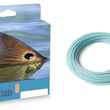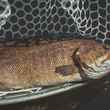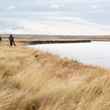I know a few really dedicated tenkara anglers — some of these folks won’t touch a traditional fly rod, no matter what and no matter when. They are complete converts, and that’s totally fine.
While I enjoy tenkara angling, particularly on small water, I tend to stick with traditional fly gear most of the time — I like the casting aspect of fly fishing too much to devote more than just a day or two here and there to the crafty art of tenkara.
That is, until winter.
This time of year, my tenkara rods come out of the closet and they get a workout on local waters. There’s just no better time to fish Tenkara than when the thermometer dips during these cold “R” months.
First, river levels are generally low, making some stretches of normally inaccessible water perfectly wadeable. Fish are concentrated in deeper runs and pools, and that means high-stick nymphing can be effective. And don’t let anybody tell you differently — there’s no better high-stick nymphing rod than a supple 13-foot tenkara rod that allows you to control the depth and speed of your drift. With the right flies at the right depth, winter tenkara fishing can be downright deadly.
Where I live, within short drives of the Henry’s Fork, the Teton and the South Fork, this time of year is frigid. It’s January and a quick look at the 10-day forecast shows a high temperature of 27 degrees. That may seem extreme, but it’s perfectly normal this time of year — we may go a full month without cresting 32 degrees. Maybe longer. For traditional anglers and fly fishers, this means frozen rod guides and the challenges that come with them. For tenkara anglers … well, nothing really changes. When you fish with nothing but a rod, a line and a fly, there’s not much to freeze.
Technique isn’t an issue, either. On sunny winter days when midges are popping and trout or whitefish are on top, the ability to have nothing on the water but the fly is advantageous. When it’s cold and gray and the fish are tight-lipped and rubbing their bellies on the bottom, being able to put a Perdigon nymph in front of their faces is equally helpful. Traditional anglers might be looking at a line change to reach fish holding deep — at the very least, they’re changing tippet length or maybe tying on new leaders altogether.
Believe me, I’ve heard the logic that many traditional anglers espouse when it comes to tenkara. No, you can’t throw 50 feet of line. And no, you can’t drop line and let streamers swing like you can with a traditional rod. But remember, it’s winter. Those long casts aren’t terribly necessary when river flows are low and fish are exactly where you think they are. And if you think you can’t swing a streamer with tenkara rod, you’re just plain wrong. No, you won’t swing it 60 feet below you, but again, is it really necessary to try and control so much line when you walk right to the edge of trouty water on most rivers during the dead of winter?
Tenkara rods are also compact, and while that might not seem like a huge advantage, consider how long it takes you to break down your gear at the end of a long, cold day. Boots and waders are universal requirements, and most of us, with ice-chilled toes and frozen waders, are forced to take our time “disrobing” streamside. If you’re a tenkara angler, your rod telescopes down to a two-foot-long tube, and, if you use clips that serve to hold line, there’s no need to remove the line from the lilian (the little nylon tag that’s heat-glued to the tip-top of the rod). Slide it down and hop into the truck and its heated seats and warm up. Meanwhile your traditional angling buddy is reeling up line, breaking his rod into four pieces, sliding those pieces into a rod sock and then sliding the sock into a tube. By the time he gets in the truck, the feeling is already returning to your fingers and toes.
I get it. Tenkara’s not for everyone. But I do believe that it can be for everyone at certain times. And the best time is now, when simple and subtle is often better. If you’re “tenkara curious,” ‘tis the season to give this fly-fishing discipline a shot.
Still hesitant? Well, for the most part, tenkara rods are quite a bit less expensive than traditional fly rods. For instance, a high-end, complete tenkara outfit from Tenkara USA will set you back about $300. Lesser-known brands can be yours for a third of that price. Good luck finding a quality traditional fly rod, with reel, line, backing, leader and tippet in that price range.
I remember, years ago, when some of fly fishing’s elite were convinced that tenkara was going to be a “fad” — a short-lived, yet fun, diversion from the larger fly-fishing discipline. Instead, it continues to grow in popularity, largely because it’s affordable, easy to learn and … it’s effective.
And it’s most effective, in my humble opinion, in the dead of winter.
‘Tis the season.































Comments
Jonathan Antunez replied on Permalink
Definitely not a fad. Anyone who called it that is definitely not well versed in history. Fixed-line Fly Fishing, of which Tenkara is a part of, has been practiced on this little blue planet since the late paleolithic era. It has been practiced in Egypt, Macedonia, Spain, Italy, France, Bosnia, and yes England and Japan. The great early English masters: Berners, Venables, Cotton, Bowlkers, etc... were all fixed line practicioners. Really no need for anyone to get upset when all share the same heritage.
Cheers.
Guy replied on Permalink
I'm in a cold northern location and also use a tenkara rod only during the winter. I often fish a small black kebari with a beadhead nymph on the point 18" below the kebari.
I understand and share your feeling about casting, but one can certainly find satisfaction learning how to cast 18' of say, a 2.5 or 2.0 level line on 12' rod a la Masami Sakakibara.
Drew T replied on Permalink
I actually got into fly fishing via Tenkara first...then into western techniques to sharpen my skills there and to increase the range of waters I can fish. Predictably, after being spoiled with the drag free, line off water presentation of Tenkara, I still feel most at home bringing a 10.5" #3 Euro nymphing set-up to the water rigged up with a thin euro leader, with a dry fly leader rolled up for both dry dropper or pure dry fly work just in case there is surface action.
The ONLY time I felt under-gunned with the Tenkara rod was when I unintentionally chanced upon a deep slot I did not see in a fast shallow section and hooked on a chunky 20-24 incher which I swear looked at me calmly with abject disdain as I coaxed him close enough to see him, before making a decisive run to break off the 5x tippet.
Maybe this is a comfort zone thing but i feel like my catch rate is still much higher with Tenkara than with my western gear (that I am less skilled on). This is why my 12' Nissin Zerosum Tenkara rod is always inside my waders in the back as my anti-skunk insurance policy.
Ryan Lee replied on Permalink
I like your insurance policy. Going from tenkara to western is like saying you're going from champagne to beer, or from a sports car to a tractor.
Charlie replied on Permalink
Not really either.
Pages